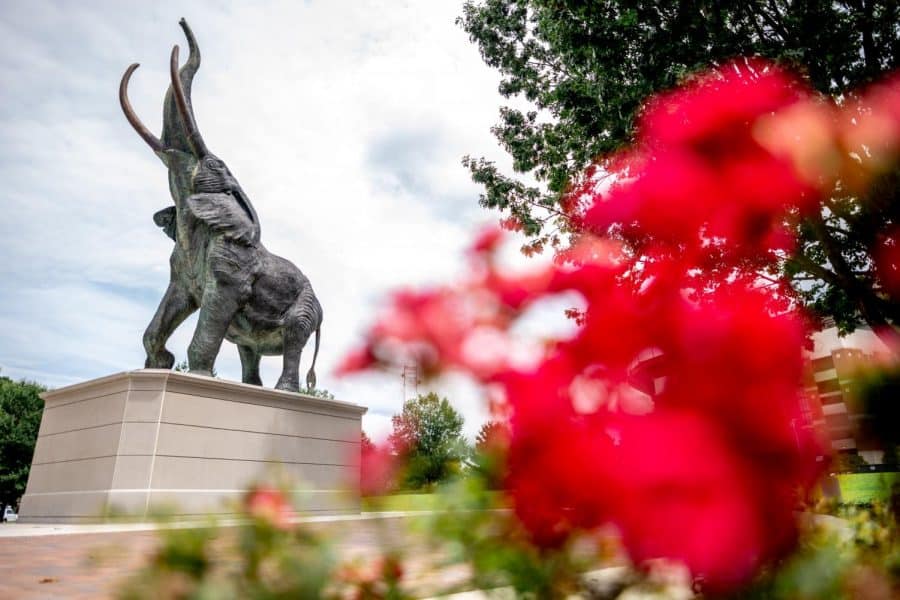Seven tons of beauty: Tuska, UA’s newest sculpture
Tuska was installed at the corner of Wallace Wade Avenue and University Boulevard in April 2021.
August 18, 2021
Students arriving on campus will notice a new addition to The University of Alabama: Tuska.
The 19-foot bronze statue modeled after an African bull elephant is hard to miss. Located near Bryant-Denny Stadium, it is believed to be one of the biggest elephant statues in the world. While many enjoy the recently added attraction, some may not know its history and how it was brought to campus.
Local Tuscaloosa businessman Jack Warner was a well-known figure due to his lavish collection of art. The now-closed Tuscaloosa Museum of Art housed many of his collected works, but Tuska, a piece by the sculptor Terry Owen Mathews, was located in front of the NorthRiver Yacht Club.
In the 1990s, Warner became a collector of Mathews’ art and sculptures, particularly those involving elephants.
“He already collected a few of my elephant statues for his yacht club,” Mathews said. “He said to me that he wanted an elephant piece that was really outstanding, so he commissioned me to do that for him.”
Born in England in 1931, Mathews was raised in Uganda and educated in Kenya and England. He spent the first career path of his life as a safari guide in the ‘50s and ‘60s.
While guiding a safari tour in 1968, he was accidentally shot by a bird hunter. He lost vision in one of his eyes, and he could no longer properly lead safaris.
This tragic accident led to Mathews’ second career, when he came into sculpting with no formal training.
His particular focus on animals such as lions and wildebeests was due to his background in safaris and his love for African wildlife.
“I’ve always loved elephants,” Mathews said. “When I could see, I was always keen to watch them because they’re always doing something interesting. They are, in a lot of ways, like human beings.”
The process of making Tuska wasn’t easy. Originally titled “Reach for the Sky,” the sculpture was made in a foundry in Gloucestershire, England, starting in 1999.
Due to the size of the statue, the molds of Tuska had to be divided into 11 separate pieces that were later put together.
“The maximum that most foundries can pour in one piece is two tons,” Mathews said. “So we cast the four legs, two tusks, the trunk, the head, the shoulder, the back and the tail.”
According to Mathews, the heaviest piece of Tuska was the rear end, which weighs two tons on its own. In total, the elephant statue weighs seven tons.
After the bronze molds were finished, the pieces of the statue were delivered via boat on Sept. 7, 2000. They were then assembled in Tuscaloosa, making the total completion time roughly one year.
After Warner’s passing in 2017, the NorthRiver Yacht Club decided to gift his favorite work of art to The University of Alabama.
UA President Stuart Bell said the process of moving the statue from the yacht club to its current location on the corner of University Boulevard and Wallace Wade Avenue was made possible by a former athletic director’s donation.
“Bill and Mary Battle made a gift that would allow for the podium to be built and landscaping to be done around Tuska to offset some of the costs of actually physically moving it to the University,” Bell said.
Since the completion of the statue’s plaza before A-Day weekend, Bell said the opportunities for students and visitors to take pictures has had a great turnout.
“It’s really popular on campus,” Bell said. “It’s getting to be one of those few spots that people want to stop and take pictures in front of, like Denny Chimes and the President’s Mansion.”
UA Vice President of Student Life Myron Pope said the placement of the statue by Bryant-Denny Stadium seemed appropriate, and its popularity is paying off.
“It just seemed like the right place to place it,” Pope said. “I’m constantly seeing people taking pictures there. It’s a great addition to campus for sure.”
While the completion of the move is recent, Bell anticipates the hype for photo opportunities will continue moving forward.
“It’ll be one of those places where folks will be like, ‘Hey, let’s meet over at Tuska and take photos,’ and we’re seeing that already,” Bell said.
Pope also believes Tuska will be a lasting icon to the University, especially since elephants are a prominent symbol for the Crimson Tide.
“I think the elephant certainly has been a significant part of our culture as an institution and a very important part of the tradition we have here,” Pope said.





















